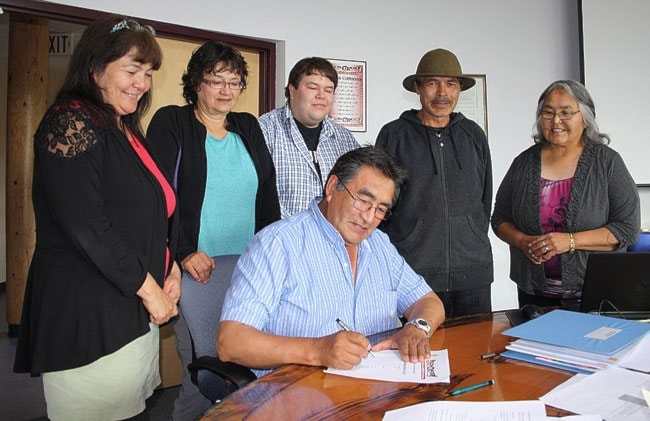Leaders of the Champagne and Aishihik First Nations hope a pioneering policy will help revitalize and strengthen their endangered language, Southern Tutchone.
The Dakwanje Language Act, the first of its kind among Canadian self-governing First Nations, was formally passed into law on July 11 during the CAFN general assembly.
The act serves as a guide to fulfill two purposes.
The first is to provide direction for and state the commitment to the restoration and revitalization of Southern Tutchone and other traditional languages for the people of the Champagne and Aishihik First Nations.
The second is the principle that people have a moral and ethical obligation to protect and encourage the use of the language.
Councillor Mary Jane Jim said fluency in Southern Tutchone, a member of the Athapaskan language family, is in rapid decline and it’s important to find creative ways to pass it on to younger generations.
“Those people who are fluent speakers, they’re few and far between,” she said.
“The people who speak the language fluently are 60 and older and it was hard for those of us who went to residential school to learn it. It’s up to individuals like me to learn the language but if you don’t hear it on a consistent basis, you don’t learn it.”
Some elders in the community are really excited about sharing the language, Jim added, but those who want to speak it need to have the incentive to learn it and have it as part of their daily life and governing structure.
The act also requires the CAFN government to seek advice, assistance and recommendations from the Elders Senate and the Youth Council before adopting a language mandate that establishes key priorities and strategies for departments to follow. It’s believed several hundred speakers of the language remain today.
“We’re not going to recreate new programs, we’re going to try and build on existing resources and maybe become innovative in allowing some of those resources to become part of our development,” Jim said.
Some of those resources include language classes and a language nest, a program that targets pre-school aged children.
The nest program, modelled after one used by the Maori people of New Zealand, runs daily at the Haines Junction Shawkwunlee Daycare for children aged 18 months to five years old.
“The children of the language nest are quick learners and pick up the Southern Tutchone language accurately and quite quick,” wrote language co-ordinator Millie Joe.
“They are comfortable speaking in the language to our elders at gatherings and potlucks. You can see the pride as they interact.”
Staff language sessions also take place twice a week in the mornings and consist of a series of language achievements, Joe said.
For youth, there are interactive language games in Southern Tutchone at the Haines Junction youth centre.
Next week, a summer language immersion camp will be taking place from Aug. 1-5, with traditional and cultural activities conducted in full immersion of the language. “We are blessed to have our fluent speakers assist in so many ways,” Joe said.
Jim said she’s very impressed with young people’s interest in learning the language and believes the mandate will allow the First Nation to put some much-needed resources to work.
“I for one am really feeling positive that we can revitalize the language to a healthy status,” she said.
“There is no doubt our children are already interested in learning it.”
The Champagne and Aishihik First Nations have a membership of approximately 1,130.
Contact Myles Dolphin at myles@yukon-news.com
